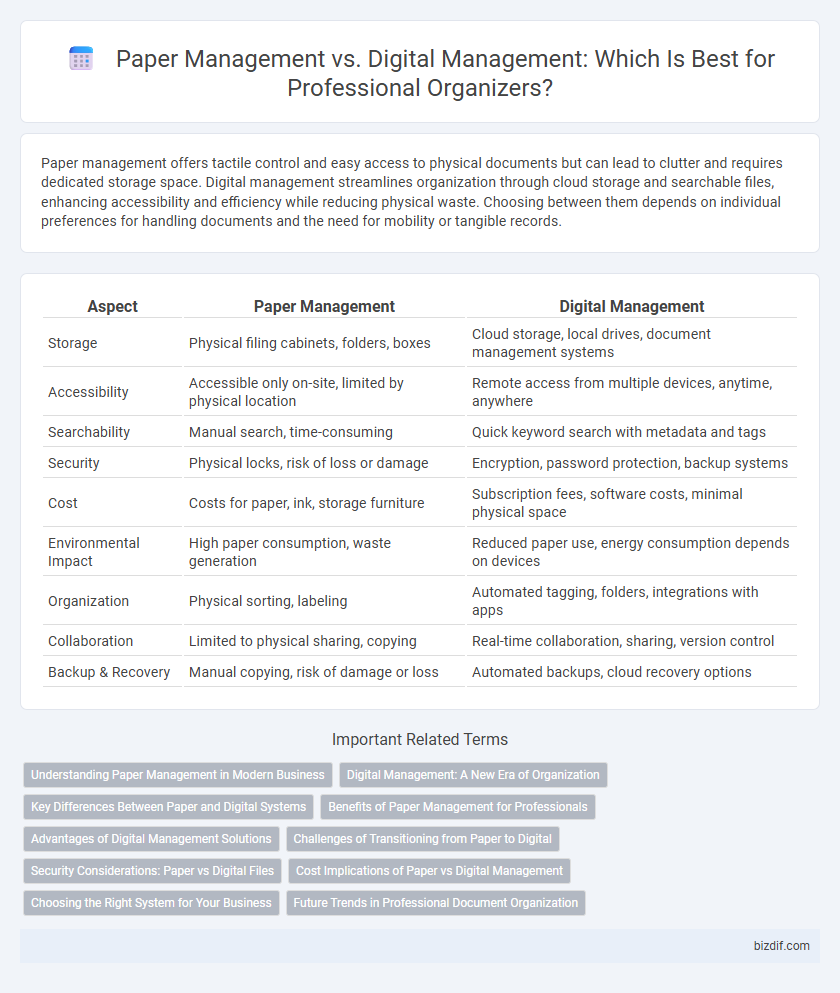Paper management offers tactile control and easy access to physical documents but can lead to clutter and requires dedicated storage space. Digital management streamlines organization through cloud storage and searchable files, enhancing accessibility and efficiency while reducing physical waste. Choosing between them depends on individual preferences for handling documents and the need for mobility or tangible records.
Table of Comparison
| Aspect | Paper Management | Digital Management |
|---|---|---|
| Storage | Physical filing cabinets, folders, boxes | Cloud storage, local drives, document management systems |
| Accessibility | Accessible only on-site, limited by physical location | Remote access from multiple devices, anytime, anywhere |
| Searchability | Manual search, time-consuming | Quick keyword search with metadata and tags |
| Security | Physical locks, risk of loss or damage | Encryption, password protection, backup systems |
| Cost | Costs for paper, ink, storage furniture | Subscription fees, software costs, minimal physical space |
| Environmental Impact | High paper consumption, waste generation | Reduced paper use, energy consumption depends on devices |
| Organization | Physical sorting, labeling | Automated tagging, folders, integrations with apps |
| Collaboration | Limited to physical sharing, copying | Real-time collaboration, sharing, version control |
| Backup & Recovery | Manual copying, risk of damage or loss | Automated backups, cloud recovery options |
Understanding Paper Management in Modern Business
Paper management in modern business involves organizing, storing, and retrieving physical documents efficiently to ensure accessibility and compliance with regulatory standards. Effective paper management reduces clutter, minimizes the risk of lost information, and supports audit preparedness by maintaining well-labeled files and secure storage solutions. Integrating paper management with digital workflows enhances overall productivity while addressing challenges specific to physical document handling.
Digital Management: A New Era of Organization
Digital management revolutionizes professional organizing by enabling instant access, seamless collaboration, and enhanced document security through cloud storage and advanced indexing systems. Automated workflows and AI-powered sorting reduce clutter and increase efficiency, transforming traditional paper-heavy processes into streamlined, eco-friendly operations. Businesses adopting digital management report up to 40% time savings in document retrieval and a 60% reduction in physical storage needs.
Key Differences Between Paper and Digital Systems
Paper management systems rely on physical documents, offering tactile organization and easy annotation but require significant storage space and risk physical damage or loss. Digital management systems utilize software platforms for document storage, searchability, and sharing, enhancing accessibility and collaboration while demanding cybersecurity measures and digital literacy. Key differences include accessibility, space requirements, risk factors, and ease of updating or sharing documents, influencing the choice based on organizational needs and preferences.
Benefits of Paper Management for Professionals
Paper management offers tangible, easy-to-access documents that enhance focus and reduce screen fatigue for professionals. Physical files improve memory retention and provide a reliable backup in cases of digital failure. Organizing paper records also supports legal compliance and simplifies audit processes.
Advantages of Digital Management Solutions
Digital management solutions offer enhanced accessibility and organization by enabling instant search, cloud storage, and easy sharing of documents across multiple devices. These solutions reduce physical clutter, minimize the risk of lost paperwork, and provide automated backup options that improve data security. Advanced features like tagging, version control, and integration with other digital tools streamline workflows and increase productivity in professional organizing.
Challenges of Transitioning from Paper to Digital
Transitioning from paper management to digital management presents challenges such as data migration complexities, ensuring digital security, and adapting to new organizational workflows. Businesses often struggle with organizing vast amounts of physical documents into searchable digital formats while maintaining data integrity. Employee resistance and the need for comprehensive training further complicate the shift to efficient digital document management systems.
Security Considerations: Paper vs Digital Files
Paper management offers physical security benefits such as controlled access and the absence of cyber threats but is vulnerable to risks like fire, theft, and natural disasters. Digital management provides enhanced security features including encryption, password protection, and secure cloud storage, yet it requires robust cybersecurity measures to prevent data breaches and hacking. Balancing both methods demands tailored strategies to protect sensitive information while ensuring efficient access and compliance with privacy regulations.
Cost Implications of Paper vs Digital Management
Paper management incurs ongoing costs such as purchasing supplies, storage space, and document maintenance, while digital management involves upfront expenses for software, hardware, and cybersecurity measures but offers long-term savings through reduced physical storage and streamlined access. Digital systems minimize costs related to printing, filing, and physical document handling, leading to increased efficiency and lower labor expenses. Investing in digital management solutions improves return on investment (ROI) by reducing overhead and enhancing document retrieval speed, critical factors for professional organizing businesses.
Choosing the Right System for Your Business
Effective paper management involves organizing physical documents with filing systems, labels, and storage solutions that ensure easy retrieval and security. Digital management utilizes cloud-based software, electronic filing, and automated workflows to streamline document access, reduce clutter, and enhance collaboration. Choosing the right system for your business depends on factors such as the volume of documents, team preferences, budget constraints, and compliance requirements.
Future Trends in Professional Document Organization
Future trends in professional document organization emphasize a shift from paper management to digital management, leveraging cloud-based platforms and AI-powered tools to enhance efficiency and accessibility. Smart categorization, automated indexing, and secure digital archiving are transforming traditional filing systems into dynamic, searchable databases. Integration of blockchain technology and advanced encryption methods is expected to boost data security and compliance in digital document management solutions.
Paper management vs Digital management Infographic

 bizdif.com
bizdif.com